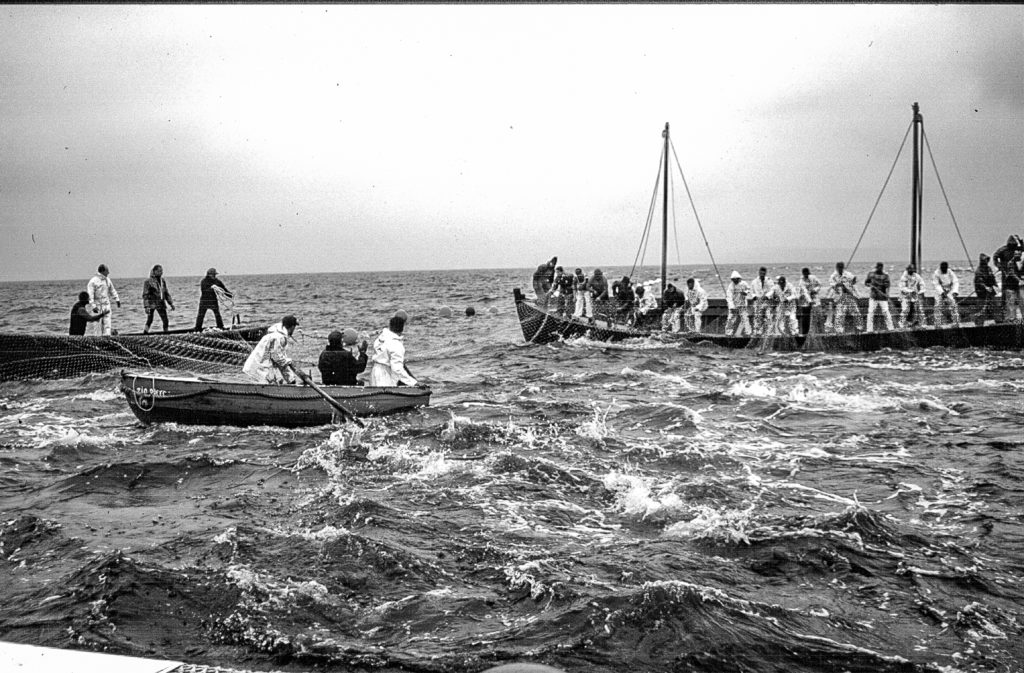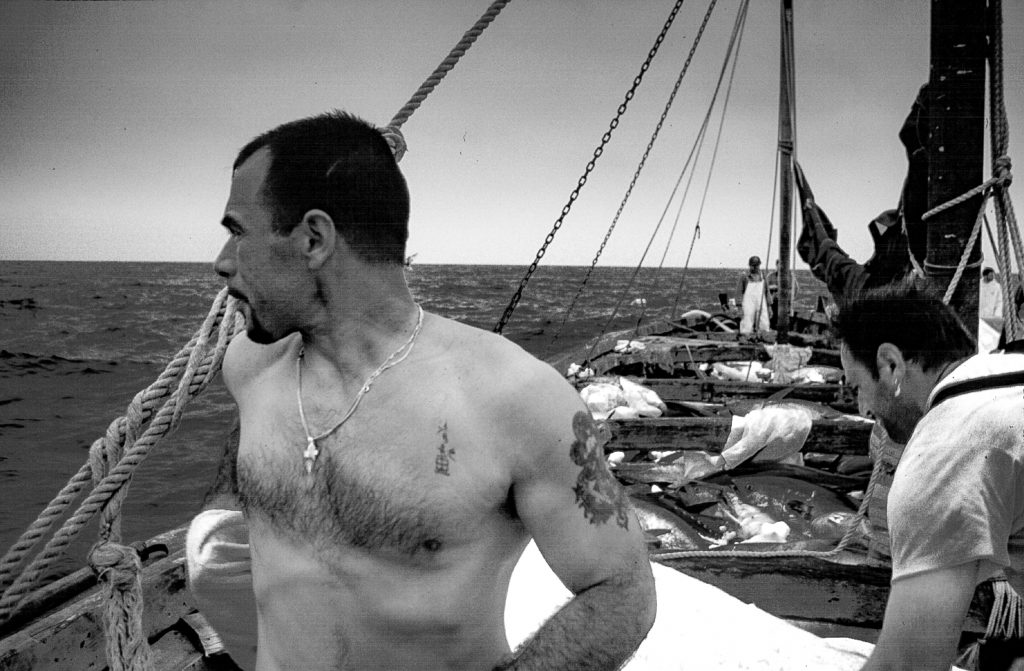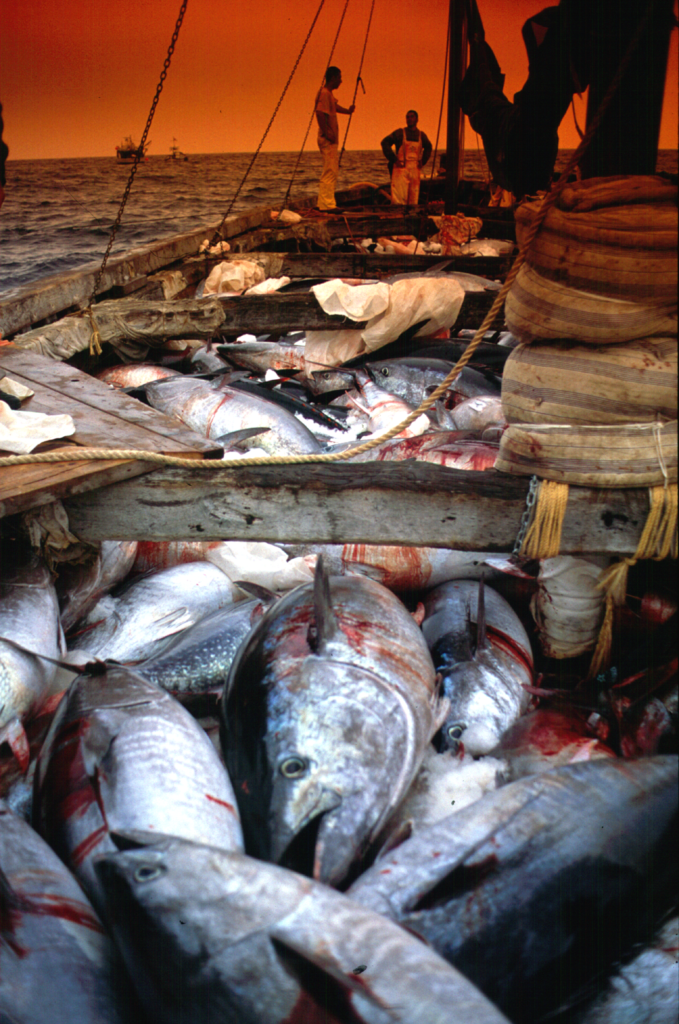It was considered a virtue not to talk unnecessarily at sea. (E. Hemingway)
It is early in the morning when I travel the road that leads to the Punta. I drive calmly thinking that I’ll be early when I see the lights that illuminate the great construction. The number of lights are not enough to get an idea of the size of the structure in which the Tonnara is housed. Staring at it absentmindedly, the information and material collected over the last months spring to mind.
Books, magazines and even simple notes written down by the locals became the memory written on the grave stones of such a flourishing industry. In the mid-seventies the waste and discharge from a new industry (the industrial port) was apparently leading to the decline of the tuna fishing industry.
Even if you were sure of the reasons for why the tonnarotti did not see much tuna during those years, some even pointed to the professionalism of the Rais (the chief of the crew). Maybe he had been guilty of having dropped the fishing nets too late. Controversy and mutual accusations did not increase the number of fish in the nets in that part of the sea. To the contrary, the poor fishing seasons still continued, while the elderly of the Paise (the town of Carloforte) remembered the fishing in which thousands of those silvery creatures of the sea were captured. Beating unsurpassable records from one season to another.

The wait
I arrive in the square in front of the building on time. I still stand a little longer to observe the place from the outside and a sky that does not bode well. The night before I had been informed that the slaughter would be dependent on a good condition of the sea and also the presence of a good number of fish in the nets. Opposite is the Isola Piana, with the old fishing establishment, now a luxury residence for tourists. It is perfectly illuminated in contrasts to the poor lights here in the Punta which barely do their duty. Taking my faithful Nikon, I approach the front door. I ring the bell and I wait. A voice in the typical accent of the place responds, making me feel far from my own Sardinia. The door opens and distracts me for a moment from my thinking. “Good morning” – a boy in a yellow oilskin jacket receives me – “if you want to wait, the Doctor is coming”. I thank him as he goes back to his duties. Now I am inside that great wall that blocked the view of the square walked on by generations of fishermen. I mount the 28mm lens on the camera body and start shooting. Everything has remained as it once was. From Marferaggi, the area where the tunas are processed after the sea slaughter, a strong and nauseating smell of fish emanate, which makes the atmosphere even more surreal. This is what is missing from books and photographs, being able to relay the smells of the moment which is not of small importance. A voice behind me makes me jump – “The boat is waiting for us at the pier, if she’s ready we can go”. My hand reaches out to a man in his sixties, with a mustache that gives him an aristocratic air and, hidden under the oilskin jacket, an elegant suit that looks somewhat out of place for the event. A fishing boat is moored by the small pier of the Tonnara and around it a lot of hustle and bustle. Some people are loading a multitude of white bags. “I’m sorry but we will travel a bit uncomfortable, we need ice to protect the fish from the heat”. The lawyer, as he’s called here by all the men, gets on the boat giving orders left, right and centre. The load is not symmetrical and he moves some bags to one side. Softly the boat sails, giving me the opportunity to take some pictures of the Tonnara from the sea.
It gets darker and darker, and the grey sky tells me that I possibly have missed the day. But these are special days and the kindness shown by these people waiting for me and taking me out are more than enough for me. The fishing, which always takes place between May and June, exploits the period in which the reproductive instinct brings tuna to migrate to some areas of the Mediterranean, namely Northern Africa, Sicily, the Tyrrhenian and Ionian on the west coast of Sardinia.

On the high seas
Now even the sea does not seem so calm and the impression I had onshore becomes more and more real as we move away from the coast. “It’s a good mistral (mistral is a wind from North-West), it’s better to take shelter here behind the stern” – a boy, not more than twenty years old, but with the air of a sea-dog, remains standing, his body moving with the waves that run from the north west. As I approach like a monkey clinging to the handrail, I see that he has the expression of one who can manage to stand without any help in this sea.
He scans the horizon as if the journey will take him far away, but he knows that his more experienced companions are already out there on site to prepare this event that is anxiously anticipated every year. Perhaps he thinks about when he can become the Rais. The undisputed leader of that brave crew who always saw him return to shore with the precious catch and who were his heros until yesterday. Today they are his teachers from whom he must learn courage and also dexterity. This is not fishing for everyone. Here you must know how to act, how to move or you risk putting your or other’s safety at risk.
If the sea gets worse I will not be able to take any pictures. The bow of the boat raises and splash water everywhere and the wind is really strong, but the only one who seems worried is me. The crew is quiet until the point the stern boy points with his hand and shouts: “Here they are”. In the distance some dark boats can be glimpsed. The boats are moored and linked together around the perimeter of the death chamber which is the fishing nets. There is no longer that transparency of the shallow water and the intense blue of the water contrasts sharply with the wake of our boat. The high cliffs frame this monochrome picture painted by the dark colours of the sky and the sea.”Yes, we have arrived” – The lawyer leaves the wheel house and now he too scans the sea in the same way as the boy. As if the old man had also lived the same moment, participating as a trembling spectator waiting for the men whom he today directs with fake detachment. His eyes light up in front of the row of boats full of fishermen ready to act. He can’t wait to know how much tuna they will pull from the darkness of the depth. The boat, tossed by the waves, pulls over and positions us side by side with a large boat on which we are proceeding to fix several white sheets. Similar to a shroud, they will be used to lay the slaughtered fish. The movements of all are precise and no one asks the other what to do, while the tension is cleverly masked by simple and age-old gestures.

The Arena
Everything is ready when the lawyer points out to me a boy with a goatee and a strong and decisive look. “That boy can do it, he’s the Rais”. Standing on the Musciara, a small boat with bright colours, halfway between our boat and the vessel that closes the square of the death chamber. He launches some orders and immediately the big boats start moving. The crew in front of us begin to pull the nets with slow movements to the rhythm of the shouts of their commander who controls, from inside the wheel house, that everything proceeds as it should. The Rais, undoubtedly the undisputed leader of the slaughter, has worked all year for this event. Chief of staff, network engineer, connoisseur of men and the sea, he had a huge responsibility. Even today, after centuries, he is there in his place as director of one of the most dramatic performances in history. The tension begins to be felt and someone shouts swearwords of all kinds while the net continues to rise from the depths and along with it the unaware prisoners. “There are many this time” – The lawyer staring at the centre of the ring made up of boats seems to calculate the number of tuna on the basis of the fatigue felt by his men. While the Rais on the Musciara begins to move under the first splashes caused by the agitation of the trapped animals. These are tense moments in which the man is afraid of the animal. Still strong, determined not to be captured without having first fought or sought an impossible escape route. Everyone’s faces are a mask of suffering. The more the circle closes the more they struggle. Now chaos is total. The sea fills with froth and the crazy tuna splash on the surface hitting each other, spinning like drills in search of a hole in the net. Shooting one photo after another risking also to fall overboard but continuously excited by the unique show that resembles a stormy sea. I am reminded of what the old men told me, recalling the head fisherman who, with a hand holding a crucifix, prayed with his companions just before starting to pull the nets. A Hail Mary followed by prayers to Sant’Antonio, San Giorgio, San Gaetano and “San Pè”, San Pietro, “To send us a good catch”. Only now do I understand why. The bodies of the animals exhausted by their own agitation, float on the surface. “You see, the fish are no longer hit when they are still in the water, today we hoist them on board once tired and then harmless” – the boy of the boat, having noticed my intrigued look begins to explain the evolution of fishing over the years. “Here, the tuna is approached by the boats and hooked to that hoist. It’s much simpler and less dangerous for us“. In fact, the water remains clean until the end and you can count the fish caught. They are different sizes and weighs from fifty kilos up. Lying on the deck of the boat like a mass grave, they spend the last moments of their lives, continuing to struggle, far away from the sea that saw them move so far with incredible elegance. A shout from the crew declares the end of the turmoil. Today we can be satisfied. The best tuna of the catch, will be shipped away tomorrow. Staring at the vessel overloaded with fish, I smile, imagining a table spread with those fine meats where a small family, maybe as far away as Japan, eat lunch. Unaware of the distant place where an ancient fishing method took place, one that is repeated year after year, century after century, with the same acts and the same passion. It’s all over. It rains a little while we are towed to shore by some motor boats. With my eyes I take a look at the tested faces of the men of the crew, silence has fallen among them. I think it’s exhaustion. I want to believe in their respect for those fish the sea battlefield kindly granted them this year.
(Translated from Italian by Bee Jensen)
